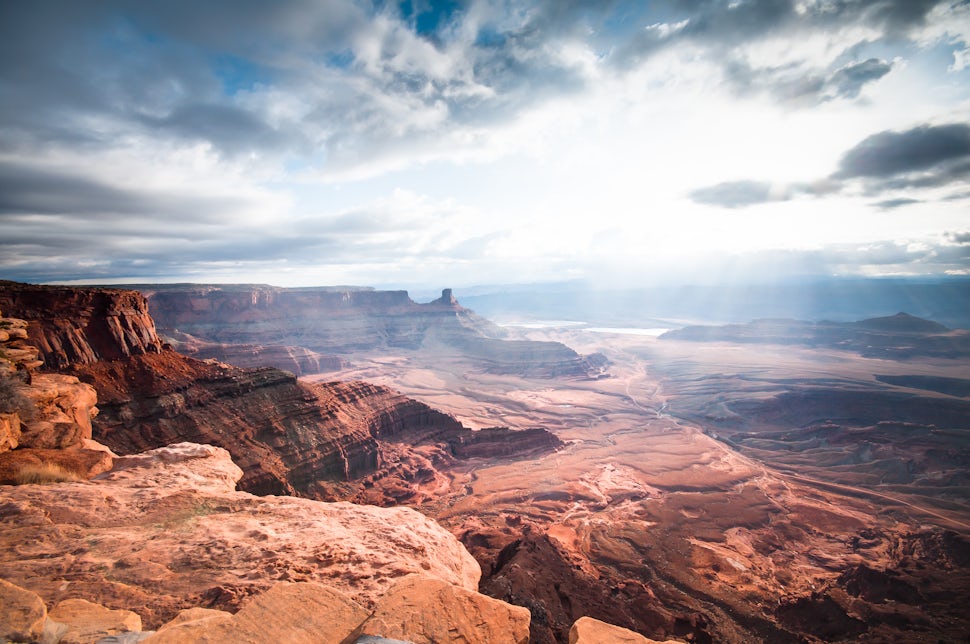5 Reasons Why You Should Explore Southern Utah In The Off-Season
It’s no secret that Southern Utah is rad.

Home to five national parks and a dozen other landscapes that easily could be, “southern Utah” is scribbled on bucket lists in dozens of languages. (Sorry locals: Your secret is out.) Any day spent exploring Southern Utah is a good day, regardless of crowds, sunburn, full campgrounds or expensive hotel rates.
But what if you could bypass some of those potential bumps in the road to southern Utah? Good news...you can! Below are five great reasons to hop in the car, point it toward the desert, and enjoy everything you love about southern Utah without some of the things you don’t love so much.
1. You’ll have the place to yourself.
It’s what “off-season” means. Most visitors come to Southern Utah in the late spring, summer, and early fall. Time your trip just right and you can have even some of the most popular destinations completely to yourself.

2. Snowy red rocks make for amazing scenery and photography.
Scenery über alles, korrekt? Southern Utah’s red rock is already extraordinarily photogenic in summer, but the whole range of yellows, whites, reds and maroons take on a new depth dusted in snow. There aren’t many deserts with wintry conditions that afford these views, and it’s a sight worth seeking out. Bryce Canyon (9,000 ft) and Cedar Breaks (10,000 ft.) are your best bets, but a few inches of snow will stick around after a December–February storm in Moab, too. And the La Sal Mountains — the ones you see through Delicate Arch's unblinking eye — stay snowcapped just about all year round. Fire away, you aspiring Ansel Adamses.
3. It's warm(ish)!
Listen, I love the place, and I’d never talk you out of visiting, but we’re talking about a desert. Summer may not be the best time to visit. (Unless you’re A. going canyoneering in one of southern Utah’s amazing, shady slot canyons; or B. my bulldog Polly, who falls asleep with her smushed face smashed against the heater vent.) Two words. HOT and DRY. Which turns into an advantage in the off-season. In January, Zion’s average highs are in the mid-50s and Moab’s are mid-40s. That’s T-shirt weather if you’re traveling from somewhere frigidly northern.

4. The stars are brighter.
Southern Utah is known for having some of the darkest skies and best stargazing opportunities in the country. In summer months you’ll catch the hazy, full views of the milky way, During the winter months, when the planet faces away from the center of the Milky Way, there’s a lower concentration of stars in our galactic view, making each one shine brighter. Bring a telescope. Even binoculars will do.
5. Accommodations are cheaper and easier to find.
You won’t be fighting for a camping spot if that’s your style, and most hotels cut their rates when the crowds thin out, too. Off-season rates are cheapest in January and February, but you can still get a deal in what’s called the “shoulder seasons,” late fall and early spring. Check out some of southern Utah’s great options for hotels, cabins, resorts, and more.

Cover photo: Jason Hatfield
Don't see your favorite adventure on The Outbound? Show us by creating an adventure.
We want to acknowledge and thank the past, present, and future generations of all Native Nations and Indigenous Peoples whose ancestral lands we travel, explore, and play on. Always practice Leave No Trace ethics on your adventures and follow local regulations. Please explore responsibly!
Do you love the outdoors?
Yep, us too. That's why we send you the best local adventures, stories, and expert advice, right to your inbox.








